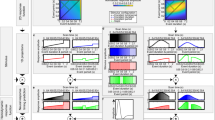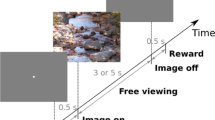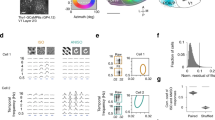Abstract
It is generally assumed that perceptual events are timed by a centralized supramodal clock. This study challenges this notion in humans by providing clear evidence that visual events of subsecond duration are timed by visual neural mechanisms with spatially circumscribed receptive fields, localized in real-world, rather than retinal, coordinates.
This is a preview of subscription content, access via your institution
Access options
Subscribe to this journal
Receive 12 print issues and online access
$209.00 per year
only $17.42 per issue
Buy this article
- Purchase on Springer Link
- Instant access to full article PDF
Prices may be subject to local taxes which are calculated during checkout


Similar content being viewed by others
References
Buonomano, D.V. & Karmarkar, U.R. Neuroscientist 8, 42–51 (2002).
Johnston, A., Arnold, D.H. & Nishida, S. Curr. Biol. 16, 472–479 (2006).
Morrone, M.C., Ross, J. & Burr, D. Nat. Neurosci. 8, 950–954 (2005).
Melcher, D. Curr. Biol. 15, 1745–1748 (2005).
Thompson, P. Vision Res. 21, 337–345 (1981).
Kanai, R., Paffen, C.L.E., Hogendoorn, J.H.A. & Verstraten, F.A.J. J. Vis. 6, 1421–1430 (2006).
Macknik, S.L. & Martinez-Conde, S. J. Cogn. Neurosci. 16, 1049–1059 (2004).
Galletti, C., Battaglini, P.P. & Fattori, P. Eur. J. Neurosci. 7, 2486–2501 (1995).
Duhamel, J.R., Bremmer, F., BenHamed, S. & Graf, W. Nature 389, 845–848 (1997).
Duhamel, J.R., Colby, C.L. & Goldberg, M.E. Science 255, 90–92 (1992).
Leon, M.I. & Shadlen, M.N. Neuron 38, 317–327 (2003).
Bueti, D. & Walsh, V. J. Cogn. Neurosci. F 58, 335 (2006).
d'Avossa, G. et al. Nat. Neurosci. 10, 249–255 (2007).
Karmarkar, U.R. & Buonomano, D.V. Neuron 53, 427–438 (2007).
Morgan, M.J., Giora, E. & Solomon, J.A. J. Vis. 6, 1012 (2006).
Acknowledgements
This work was supported by the European Commission Sixth Framework Programme (NEST, MEMORY), the Australian National Health and Medical Research Council and the Italian Ministry of Research.
Author information
Authors and Affiliations
Corresponding author
Ethics declarations
Competing interests
The authors declare no competing financial interests.
Rights and permissions
About this article
Cite this article
Burr, D., Tozzi, A. & Morrone, M. Neural mechanisms for timing visual events are spatially selective in real-world coordinates. Nat Neurosci 10, 423–425 (2007). https://doi.org/10.1038/nn1874
Received:
Accepted:
Published:
Issue Date:
DOI: https://doi.org/10.1038/nn1874
This article is cited by
-
Stimulus (dis)similarity can modify the effect of a task-irrelevant sandwiching stimulus on the perceived duration of brief visual stimuli
Experimental Brain Research (2023)
-
A supramodal and conceptual representation of subsecond time revealed with perceptual learning of temporal interval discrimination
Scientific Reports (2022)
-
Resting-state fMRI functional connectivity of the left temporal parietal junction is associated with visual temporal order threshold
Scientific Reports (2022)
-
Vestibular Perception in Time and Space During Whole-Body Rotation in Humans
The Cerebellum (2021)
-
Temporal rate is not a distinct perceptual metric
Scientific Reports (2020)



